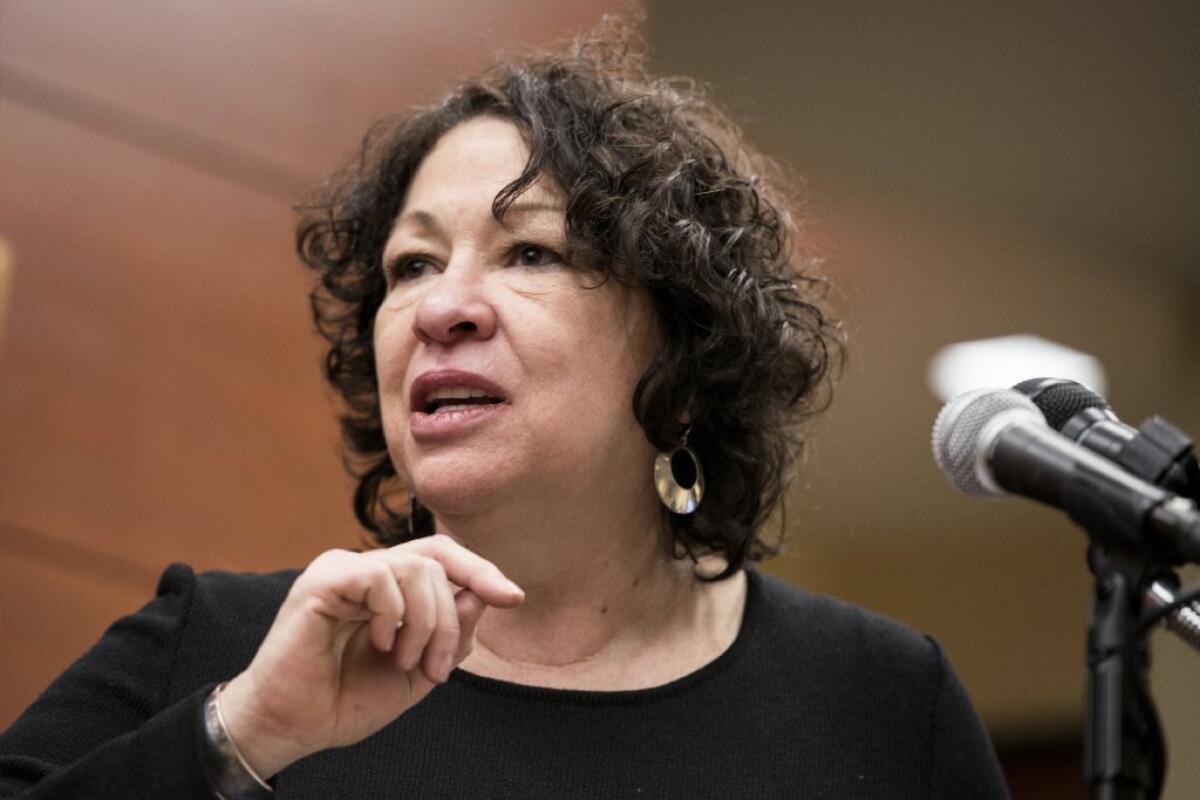Opinion: Note to media: There’s no such office as ‘female justice’

Justice Sonia Sotomayor wrote a dissent from the court’s order in a contraceptive case.
If you read news articles about a post-Hobby Lobby dispute at the Supreme Court over contraception coverage, you might think that there is an official position of “female Supreme Court justice.” Typical was the lead of this July 3 New York Times report:
“In a decision that drew an unusually fierce dissent from the three female justices, the Supreme Court sided Thursday with religiously affiliated nonprofit groups in a clash between religious freedom and women’s rights.”
The Los Angeles Times didn’t refer to the dissenting justices by their gender until the eighth paragraph of a story by my colleague David Savage: “The unsigned order prompted a sharply worded dissent from the court’s three female members, Justices Sonia Sotomayor, Ruth Bader Ginsburg and Elena Kagan.”
I’m sure some readers would accuse Savage of burying the lead, but I’m glad he didn’t begin the story by emphasizing the gender of the three dissenters.
The occasion for the protest by Sotomayor, Ginsburg and Kagan was an unsigned order by the court allowing Wheaton College, an evangelical Protestant school, to refrain for the time being from using a federal form to indicate that it had religious objections to complying with the healthcare law’s contraceptive mandate.
The three justices had dissented in the Hobby Lobby decision along with Justice — or should I call him male Justice? — Stephen G. Breyer. In an opinion for herself, Kagan and Ginsburg, Sotomayor scathingly accused other justices (perhaps including Breyer; it’s not clear) of undermining the credibility of the court.
Sotomayor noted that only a few days earlier, the majority in the Hobby Lobby case had suggested that the compromise the administration had offered religious nonprofits — allowing contraceptive coverage to be paid for by an insurer — might be a model for accommodating for-profit companies such as Hobby Lobby.
“Those who are bound by our decisions usually believe they can take us at our word,” Sotomayor wrote. “Not so today.”
Scorching stuff, but there’s nothing in the opinion that couldn’t have been written by a male justice. In fact, a lot of male non-justices in the legal and journalistic communities reacted similarly to the switcheroo of the Wheaton College order.
It’s widely accepted that the women on the Supreme Court bring a special set of experiences to the bench. But it’s a leap from that commonplace observation to the assumption that, because contraception was an issue, the “female justices” were guided by their gender rather than their reading of the law in the Hobby Lobby and Wheaton cases. I can think of a few conservative female judges who probably would have voted differently if different outcomes in the 1992 and 2008 elections had put them on the court.
When the court (following the lead of Sotomayor) issued a similar order in an earlier action involving a Roman Catholic religious group that opposed the contraception mandate, some wondered darkly if the predominance of Catholics on the court predetermined that result. That’s only slightly more problematic than assuming that Sotomayor, Ginsburg and Kagan were voting their gender.
Follow Michael McGough on Twitter @MichaelMcGough3
More to Read
A cure for the common opinion
Get thought-provoking perspectives with our weekly newsletter.
You may occasionally receive promotional content from the Los Angeles Times.











